![[SoundStage!]](../../titles/sslogo3.gif) Home
Audio Equipment Home
Audio EquipmentFeature Review |
|||||||
In a grainy black-and-white snapshot, David Wilson stands at a cluttered workbench and tinkers with a very early version of his WATT speaker. It's the late 1970s, and Wilson has designed the WATT as a monitor for his recording projects. Of course, where the WATT has ended up nearly three decades later is part of high-end-audio lore. With its companion Puppy woofer module, the WATT has become one of the best-selling and longest-lived audiophile products ever. "Better than a WATT/Puppy" has become a speaker-design mantra, likely because knockoffs of the two-cabinet platform are common. The WATT/Puppy has literally become an icon of the audio industry: This year the Consumer Electronics Association used a pictograph of the speaker to represent high-end audio during the recent CES, the electronics world's yearly cotillion. While standing at his workbench, David Wilson had none of this in mind, and yet it has all happened, and accelerated over the past decade of the WATT/Puppy's existence. Founded in 1973, Wilson Audio's first product wasn't a speaker at all. The SM.AR.T turntable was produced for a scant two years; perhaps the best example extant resides at Wilson Audio. Next, in 1977, came the recordings, dozens of them made over a 20-year period. In 1979, David Wilson began reviewing audio equipment for The Abso!ute Sound and a few years later he started writing for Mix Magazine.
It wasn't until 1985 that the first WATT hit the market, the Puppy following three years later. In the early days of the speaker system, audiophiles mixed and matched WATTs and Puppys of various vintages, causing some confusion with the speaker's nomenclature. Exactly how was a WATT 2/Puppy different from a WATT 3/Puppy 2? With the WATT/Puppy 5 the two halves of the speaker caught up to each other, and my experience with it began. I first heard the WATT/Puppy 5 along with a coffee-table-like WHOW subwoofer at an audio shop in the early 1990s. Both were trade-ins, and together they constituted a wide-bandwidth, microscopically detailed speaker system that could make you swoon with high-quality recordings -- like those David Wilson was producing -- and want to leave the room with just about anything else. That experience -- actually, it was a series of experiences over the course of half a year, until someone purchased the speakers and subwoofer -- left an impression on me that remained until the Hi-Fi '99 show in Chicago. I remember sitting through a demo of the new WATT/Puppy 6 and thinking, How can this be? It was clear that the WATT/Puppy had changed utterly and for the better. Afterwards, I approached Wilson Audio about reviewing the speakers, and in Y2K a pair came my way. The WATT/Puppy 6 was a sonic turning point for the WATT/Puppy. The high resolution remained, but along with it came a more relaxed, musically consonant presentation. The prodigious bass was still there, and so was the prodigious dynamic range. What had seemingly happened was that the sheer athleticism of earlier WATT/Puppy speakers had been mated with a command of fluid movement, and the product was a complete, rounded-out sonic presentation.
With the System 7, introduced in 2002, Wilson Audio continued down the same road, refining the sound of the WATT/Puppy to a meaningful degree. There was one significant change in construction. The System 6 WATT was made of a mineral-filled acrylic-based material that had been used for the WATT for 15 years. For the WATT 7, Wilson Audio turned to its M material for the WATT's cabinet. A costly high-tech composite used in the cabinets of all other Wilson Audio speakers, generally wherever there was a midrange driver, M material's properties -- which Wilson Audio has measured extensively -- enhanced midrange clarity. It was used in varying thicknesses along with lead ingots to make a very dense, very inert and very heavy speaker cabinet that Wilson Audio claimed was 37dB quieter than that of the System 6 WATT. I can attest to the sonic outcome. As I put it in my review, the WATT/Puppy 7 "conveys so much information in a completely natural and involving manner that it readjusts expectations for reproduction." Next, Wilson Audio did something that seemed distinct and separate at the time but ended up affecting every one of the company's speakers in short order: they introduced a new flagship speaker. I first saw the X-2 Alexandria at the 2003 CES. Later that year, the Alexandria appeared to great consumer response. Now, four years later, Wilson Audio has sold hundreds of pairs of the $135,000 speakers, taking more than a month to construct each one. With the Alexandria, Wilson Audio first identified "jitter" -- a noise artifact generated by the multiple crossovers used in the company's speakers. Jitter exhibits itself as grunge and grain that are especially noticeable in high frequencies, and methods for reducing it were one of the most important developments coming from the creation of the Alexandria. The first speaker to feel the Alexandria's touch was the MAXX 2, which came to market in late 2004. Then, in 2005, the Sophia 2 appeared, and in 2006 the WATT/Puppy 8. The WATT/Puppy 8 may represent the most radical remaking of the speaker yet, though you would never know it from outward appearances. One of the biggest changes was brought on by having to comply to European Union requirements to get the lead out -- remove the lead ingots from the WATT's cabinet. To do this, Wilson Audio re-engineered the WATT, using harder-than-steel X material for most of the cabinet and M4 material, the latest version of M material, for the front baffle. Here, the Alexandria, which was designed without lead from the ground up, showed its influence in the WATT's new complex bracing scheme. The System 8 WATT is ten pounds lighter than its predecessor, though at 50 pounds it is still heavier than you would think given its size. It's also just as inert -- like rapping on a bowling ball.
One of the important changes for the MAXX 2 was a new tweeter, and the same driver is now used for the WATT/Puppy 8. As its platform, this tweeter has a new version of the proprietary Focal inverted-titanium-dome driver that Wilson Audio has used for decades. It is torn down, refined and reconstructed. An obvious and important addition is a damping plate of X material that minimizes the effect of the tweeter's back wave, something that was once again identified during development of the Alexandria. The WATT/Puppy 8's tweeter is a different driver after reconstruction, akin to a customized car built from one you'd drive off the lot. Tweeters that use exotic materials -- diamond, beryllium -- are chic these days, but the unrestrained resolution and smoothness of the WATT/Puppy 8's tweeter makes a strong case for better execution leading to better sound. Wilson Audio prizes its crossovers, wiring all of the components by hand, trimming to a tolerance more strict than the capacitors themselves, and potting everything in specially chosen cases before installation into the speakers. As with the MAXX 2, the WATT/Puppy 8's crossovers incorporate the Alexandria's anti-jitter technology and its accompanying reduction in noise, allowing for a deeper sonic view into the speaker's ever-lower noise floor -- and the music. The WATT/Puppy 8 is slightly larger than the speakers it replaced -- 41"H x 13"W x 18.75"D -- and also slightly lighter -- 170 pounds. There are still four standard colors -- dark titanium, desert silver, Mercedes silver, and diamond black -- along with optional and custom colors limited only by your imagination. One important cosmetic change to the speaker involves the foam diffraction pads on the front, which are now recessed flush with the surface of the cabinet. The grilles attach via metal pins that fit into holes instead being held on with Velcro. I thought the old foam grilles were the most transparent ever, but I concede that the new grilles and attachment method are leagues more elegant. The grilles are available in different colors, and you even have your choice of finish for the speaker's aluminum hardware -- silver or black. The price has gone up $4000 to $27,990 USD per pair. The WATT/Puppy used to be a pricing bellwether under $20,000, but it's now pushing $30,000. While the increase is a product of inflation, rising manufacturing costs and the speaker's greater complexity, the market itself is bursting with higher-priced competition that doesn't show the engineering and cosmetic refinement of the WATT/Puppy 8. I saw and heard a lot of expensive speakers at CES this year, and none has half the backstory of the WATT/Puppy. As they have done in the past, John Giolas and Trent Workman came to my house to set up the WATT/Puppy 8s. Both have trained many Wilson Audio dealers in the art of "voweling in" speakers in customer's rooms, and they now rely on their own paperwork and masking tape on the floor to rough in where the speakers will go in my room. Most of their time was spent on fine-tuning -- moving the speakers literally fractions of an inch, the effect of which can be profound. At one point, John illustrated the difference of a half-inch movement. The sonic result was rather like two beams of light hitting the same point -- precision and intensity were increased. Because of their group delay adjustments -- which change the tilt of the WATT depending on the ear height and distance of the listener -- the WATT/Puppy 8s are tricky to configure and position for optimum sound. But after setup has been done by someone skilled, you will understand its importance.
Both John and Trent have remarked how good my room is acoustically, and I have to admit that they are right. Its size -- 29'L x 20'W x 10'H -- has something to do with it, but so do a couple of architectural features: a series of exposed beams in the ceiling that act as diffusers, and windows behind the equipment that make the room somewhat lossy, which aids in dissipating bass frequencies especially. The room is also on a concrete slab that is covered with carpet -- both good for sound. I didn't design this room from the ground up, but it certainly suits the purpose of high-end audio. John and Trent now make quick work of setting up speakers here.
To find out what it takes to be "Better than a WATT/Puppy" in 2007, check this space on April 1. ...Marc Mickelson
|
|||||||
|
|||||||
![[SoundStage!]](../../titles/sslogo3.gif) All
Contents All
ContentsCopyright © 2007 SoundStage! All Rights Reserved |

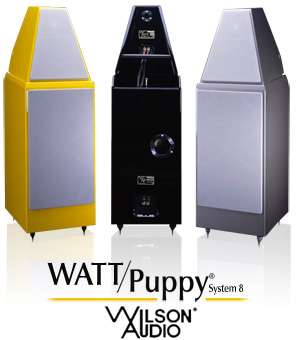

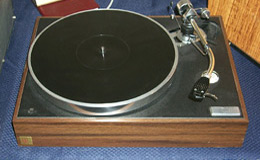
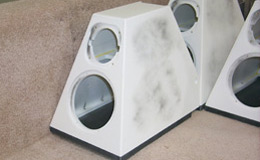
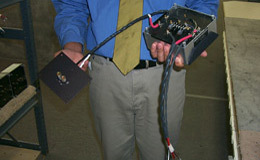

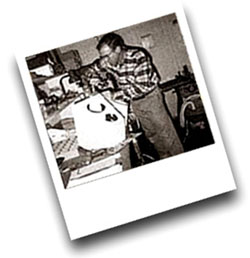 This may be the only quick
work that anyone from Wilson Audio does nowadays. The weight of the WATT/Puppy's history
is upon them. Speaker parts take hours to mill, days to construct into cabinets, weeks to
paint and cure. Existing speakers take years to reassess and improve. Completely new
models have indefinite development cycles. The rigor and attention to detail come directly
from the top -- David Wilson standing at his workbench would have it no other way.
This may be the only quick
work that anyone from Wilson Audio does nowadays. The weight of the WATT/Puppy's history
is upon them. Speaker parts take hours to mill, days to construct into cabinets, weeks to
paint and cure. Existing speakers take years to reassess and improve. Completely new
models have indefinite development cycles. The rigor and attention to detail come directly
from the top -- David Wilson standing at his workbench would have it no other way.